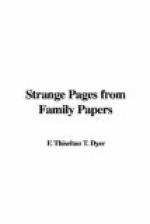By her testament, Eleanor, Duchess of Buckingham, wife of Edward, Duke of Buckingham, who was beheaded on May 17th, 1521, appointed her heart to be buried in the church of the Grey Friars, within the City of London; and in the Sackville Vault, in Withyam Church, Sussex, is a curiously shaped leaden box in the form of a heart, on a brass plate attached to which is this inscription: “The heart of Isabella, Countess of Northampton, died on October 14th, 1661.” A leaden drum deposited in a vault in the church of Brington is generally supposed to contain the head of Henry Spencer, Earl of Sunderland, who received his death wound at the battle of Newbury; and at Wells Cathedral, in a box of copper, a heart was accidentally discovered, supposed to be that of one of the bishops; and in the family vault of the Hungerfords, at Farley Castle, a heart was one day found in a glazed earthenware pot, covered with white leather. The widow of John Baliol, father of Bruce’s rival, showed her affection for her dead lord in a strange way, for she embalmed his heart, placed it in an ivory casket, and during her twenty years of widowhood she never sat down to meals without this silent reminder of happier days. On her death, she left instructions for her husband’s heart to be laid on her bosom, and from that day “New Abbey” was known as Sweet Heart Abbey, and “never,” it is said, “did abbey walls shelter a sweeter, truer heart than that of the lady of Barnard Castle.”
Among the many instances of heart-bequests may be noticed that of Edward I., who on his death-bed expressed a wish to his son that his heart might be sent to Palestine, inasmuch as after his accession he had promised to return to Jerusalem, and aid the crusade which was then in a depressed condition. But, unfortunately, owing to his wars with Scotland, he failed to fulfil his engagement, and at his death he provided two thousand pounds of silver for an expedition to convey his heart thither, “trusting that God would accept this fulfilment of his vow, and grant his blessing on the undertaking”; at the same time imprecating “eternal damnation on any who should expend the money for any other purpose.” But his injunction was not performed.
Robert Bruce, king of Scotland, the avowed foe of Edward I., also gave directions to his trusted friend, Sir James Douglas, that his heart should be buried in the Holy Land, because he had left unfulfilled a vow to assist in the Crusade, but his wish was frustrated owing to the following tragic occurrence. After the king’s death, his heart was taken from his body, and, enclosed in a silver case, was worn by Sir James Douglas suspended to his neck, who set out for the Holy Land. On reaching Spain, he found the King of Castile engaged in war with the Moors, and thinking any contest with Saracens consistent with his vows, he joined the Spaniards against the Moors. But being overpowered by the enemy’s horsemen, in desperation he took the heart from his neck, and threw it before him, shouting aloud, “Pass on as thou wert wont, I will follow or die.” He was almost immediately struck down, and under his body was found the heart of Bruce, which was intrusted to the charge of Sir Simon Locard of Lee, who conveyed it back to Scotland, and interred it beneath the high altar in Melrose Abbey, in connection with which Mrs. Hemans wrote some spirited lines:—




